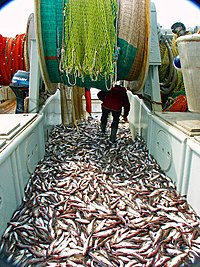
Back التنافس (علم الاقتصاد) Arabic Rivalidad (economía) Spanish Rivalité (économie) French Մրցակցային սեփականություն Armenian 非競合性 Japanese Rivaliteit (economie) Dutch Rivalidade (economia) Portuguese Конкурентное благо Russian Суперництво (економіка) Ukrainian 竞争性 Chinese

In economics, a good is said to be rivalrous or a rival if its consumption by one consumer prevents simultaneous consumption by other consumers,[1] or if consumption by one party reduces the ability of another party to consume it. A good is considered non-rivalrous or non-rival if, for any level of production, the cost of providing it to a marginal (additional) individual is zero.[2] A good is "anti-rivalrous" and "inclusive" if each person benefits more when other people consume it.
A good can be placed along a continuum from rivalrous through non-rivalrous to anti-rivalrous. The distinction between rivalrous and non-rivalrous is sometimes referred to as jointness of supply or subtractable or non-subtractable.[3] Economist Paul Samuelson made the distinction between private and public goods in 1954 by introducing the concept of nonrival consumption. Economist Richard Musgrave followed on and added rivalry and excludability as criteria for defining consumption goods in 1959 and 1969.[4]
- ^ David L. Weimer; Aidan R. Vining (2005). Policy Analysis: Concepts and Practice. Pearson: Prentice Hall. p. 72. ISBN 0-13-183001-5. Fourth Edition.
- ^ Cornes, R., T. Sandler. 1986. The theory of externalities, public goods, and club goods. Cambridge University Press.
- ^ Hess, C., E. Ostrom. 2006. Introduction. C. Hess, E. Ostrom, eds. Understanding Knowledge as a Commons: From Theory to Practice. The MIT Press, Cambridge, Massachusetts
- ^ Apesteguia, J; Maier-Rigaud, F (2006). "The Role of Rivalry: Public Goods Versus Common-Pool Resources". Journal of Conflict Resolution. 50: 647. doi:10.1177/0022002706290433. S2CID 6738663 – via SAGE journals.
© MMXXIII Rich X Search. We shall prevail. All rights reserved. Rich X Search